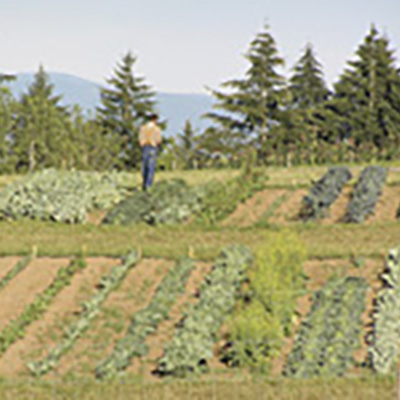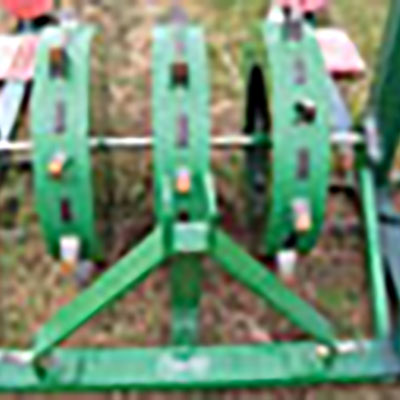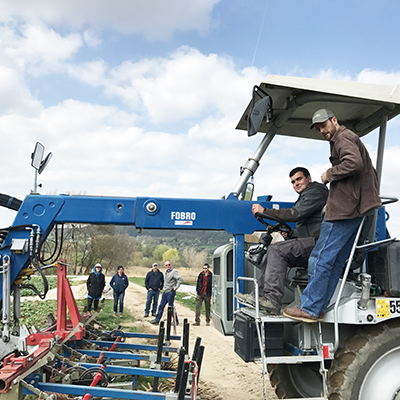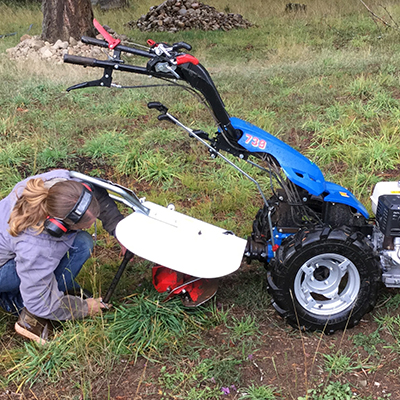This article originally appeared in the January 2017 issue of Growing For Market Magazine
Vegetable growing and all its attendant arts have been my passion for years. In its pursuit I have worked for other growers, run my own CSA, visited farms and talked with farmers throughout the country and world. Currently I am a graduate student of horticulture at Michigan State University. My work there focuses on physical weed control tools and techniques and entails investigating many weeding tools and building some as well.
My professional and personal interests in cultivation melded a few months back when my friend Paul Huber talked to me about building a cultivator for his BCS walk-behind tractor. Paul is a CSA and market grower in Wisconsin who relishes his intensive growing method, a pillar of which is his walk-behind tractor. I feel that Paul is typical of most growers using a walk-behind tractor in that he uses the machine for soil preparation but afterwards it sits idle as wheel hoes and hand tools attend to weed control. The benefits of a cultivator for Paul’s walk-behind tractor were obvious – weeding a three-row bed with a wheel hoe takes five passes whereas a tool pulled by his walk-behind would do it in one.
At first Paul and I thought that we were boldly blazing a new trail with our novel idea of a cultivating tool for his walk-behind, but after sharing Youtube videos over the course of some weeks the two of us realized that there are some amazing walk-behind weeding machines throughout the world, both homemade and manufactured, and that there are many people cultivating with walk-behind tractors. This article is an account of what we learned about walk-behind cultivation, our experience building a cultivating tool, and some of the retro-innovators that we met in the process.
Some of the many cultivators for walk-behinds. Courtesy of Jeff Lauber.
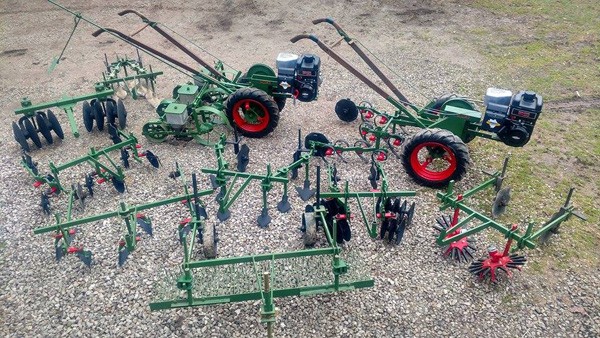
I am guessing that if you are reading this you have experienced the frustration of finding appropriate tools for vegetable growing. In general, new field-scale tools have not been mass-produced for us in this country for fifty years. You’ll find vegetable growers at auctions, scouting fence-lines, old barns, Craigslist, and all other manner of places to find old vegetable growing equipment because it is generally not readily available at a decent price. In the Johnny’s catalog one can find precision tools for growing by hand, or you can jump up to cultivating tractors and start growing by tractor. But as I found out, there is an entire style of vegetable farming and scale of tools that have been forgotten, and that is the scale of the walk-behind tractor, a style that combines many of the benefits of tractor and hand growing.
But that big picture only came into focus for me later. In the beginning the first step for Paul and I was to seek out a mysterious vegetable grower we knew only as Boodog1972. Paul had found this person’s videos posted on Youtube showing an antique walk-behind with several very modern cultivating set-ups that worked excellently. Through some internet sleuthing we tracked down this Boodog, who turned out to be a market gardener in Bellingham, Washington, named Jason Weston.
Jason was kind enough to speak with Paul and I and we peppered him with questions. He grew up working on the 5-acre market garden and took it over from his father in 2007. There had always been an old Planet Jr. walk-behind sitting around but Jason didn’t use it because of its finicky engine. However, once he replaced the original engine with a new one five years ago, a simple job, he began using the machine in earnest.
In Boodog’s movies we saw several different kinds of sparkling new cultivators, and we wondered if he was a brilliant innovator, spending hours in his shop to design and fabricate these tools. That turns out not to be the case. “All the small-scale equipment has already been made” he said, “when 10% of the population was in agriculture many more people were building tools and there was a lot more innovation.”
Below is a wire weeder, made new but based on an original Planet Jr. design. Photo courtesy of Jason Weston.
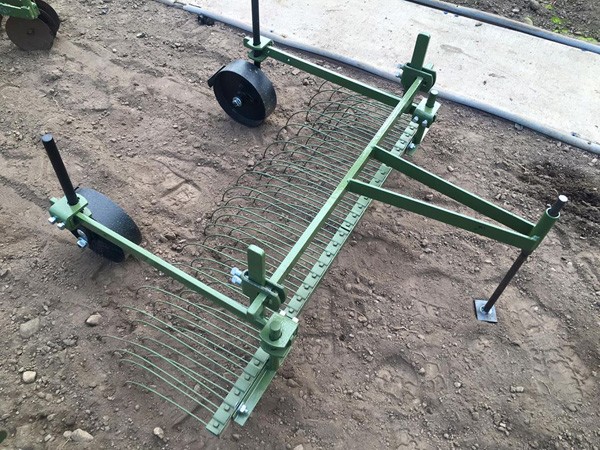
Jason began looking through old Planet Jr. equipment catalogs to see what had been made and then spent countless nights scouring Ebay looking for the old tools, “for a while every day I was just looking for clamps.” He did not have to change the way he grew when he began using walk-behind tools because they were originally designed for market growers at a 15’’ row spacing, which he already used.
From the old Planet Jr. tool catalogs Jason pieced together an understanding of the proper use of walk-behind tractors in weed control along with a nice collection of tools. I imagine you know that it is not as easy as slapping a cultivating tool to a tractor or walk-behind, a great deal of the tool’s performance depends upon the details of how it is attached to the tool-carrier. To that end, Jason distilled for Paul and I the secret of walk-behind cultivator design, and if you promise not to tell another soul I will share it with you now...
Have you experienced how an implement rear-mounted to a tractor will fly off to the opposite direction when you turn the wheel? I have, and it convinced me that cultivating equipment must be belly-mounted between the front and rear wheels of the tractor in order to give precise control. Paul and I nodded our heads and smiled as Jason described to us how tools can be ‘belly-mounted’ on a walk-behind. The thing is to have gauge-wheels on the rear of your toolbar, the further back the better. These are not actual wheels but rather they are coulters that bite a few inches into the soil. These gauge-wheels are not so much for depth control, but act as a second set of wheels. With them the tool is suspended between the front tractor wheels and these rear gauge-wheels, effectively belly-mounting the tool. Jason also pointed out that the toolbar must be attached to the walk-behind in such a way that it can swivel from left to right, and then the gauge-wheels, by biting into the ground, act as a rudder, keeping the cultivator tracking straight even when a shovel jumps on a rock.
Below, this finger weeder is “belly-mounted” on a walking tractor by putting it between the front tractor wheels and the rear gauge wheels. Almost every dimension can be adjusted with clamps. Photo courtesy of Jason Weston.
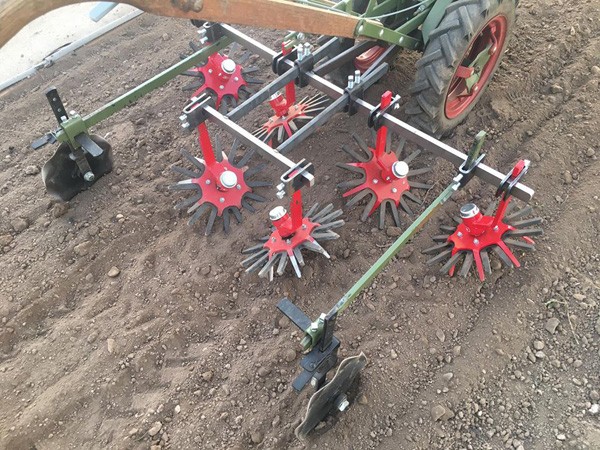
Jason’s Planet Jr. walk-behind has a clearance of about 7’’, which lets plants up to 18’’ bend underneath it. What happens when the plants get too tall to cultivate? Then he stops, “after cultivating a row 2 or 3 times most of the weed seeds in the top layer are exhausted.” We asked Jason which dimensions of the toolbar frame should be adjustable, and he responded that all angles should be adjustable. Luckily toolbars from across brands were all made with inch and a quarter bar stock, so that with the right clamps the whole toolbar can be put together allowing all distances can be adjusted.
However, Jason along with every other person we spoke to told us that adjustments are necessary only until you have the cultivator dialed-in, then just leave it alone forever. Likewise, if time is money, it makes more sense to have several cultivators that are never adjusted rather than only one that you must constantly spend time adjusting for different applications. In his parting words Jason, who was no longer the mysterious Boodog, told us to join one of the many Facebook groups dedicated to walk-behinds and the like, and so the next chapter in our walk-behind cultivation quest began.
Upon joining a group we saw the community of people that were trading tips, encouraging each other, and posting all manner of inspiring photos. Which is how we met Will Staufer, who grows on 4 acres in Ohio and sells at market. Will got into walk-behind cultivation through his onions- when cultivating with his wheel hoe he always had a 1-2’’ band unworked on either side of the plants. He felt that he needed to mechanize to be profitable, and in doing so got turned on to walk-behinds. Like Jason, Will does not invent new tools, he looks at old catalogs to get ideas and then looks for those original tools or makes reproductions. Will owns many different cultivators, such as hilling discs, duck-foot sweeps, finger weeders, beet knives, and a tine-weeder. Of course to use mechanical cultivation one must plant in exact straight lines, and to that end many growers have multiple Planet Jr. seeders mounted to their walk-behinds at precise spacings.
Finally, I got ahold of Jeff Lauber, the godfather of walk-behind tractors. Jeff has been growing with walk-behind tractors since 1977 and since then has amassed a veritable treasure trove of tractors and attachments. Jeff taught me the history of walk-behind tractors: they were first made early in the 20th century and grew in popularity through the years, then boomed after WWII with the rise of home ownership and tapered off in the sixties. Throughout that time there have been 800 different manufacturers making machines ranging from walk-behinds with dualies weighing over 1,000 pounds meant to work 25 acres, to the smaller models we are interested in that are essentially powered wheel hoes.
Jeff also told me what to look for in buying a walk-behind. Though you might find a rusty walk-behind at a yard sale for a hundred bucks, it likely is not a great deal. Remember that these machines are fifty years old or more and they can have worn gears, bushings and the like. Replacement parts are available but they require time and money. For parts Jeff recommends not going through a general parts dealer like NAPA, but rather a dealer specializing in only that type of part, such as bearings. A bearing dealer can look up your bearing and find a modern application where that size is still being used.
You can expect to pay $500 just for new tires and a new engine, though used 5hp engines can be had abundantly from broken power washers. Jeff recommends finding a walk-behind model that takes power directly from the engine, with the gear reducer or transmission mounted on the tractor. These straight crank engines are much cheaper than gear reductive engines. Gear reductive engines are built with a gear reducer box attached, but they cost a few hundred bucks more. The long story short is that if you find a well-running walk-behind with decent tires for a few hundred dollars – put down this article and buy it! You can always put a new engine on it.
In the course of writing this article such an opportunity presented itself when I saw a Simplicity tractor for sale for a few hundred dollars. I called Jeff Lauber to ask his advice and he told me to hang up on him and buy it, which I did. I ended up needing to trade my banjo for the original thin tires, so I will be whistling for a while.
Below is the author’s Simplicity tractor, with the wheels he had to trade his banjo for. He bought it because it had good tires, a new engine, no rust, a straight crank motor, and a transmission. It also came with a cultivator that has useful parts like shovels and clamps.
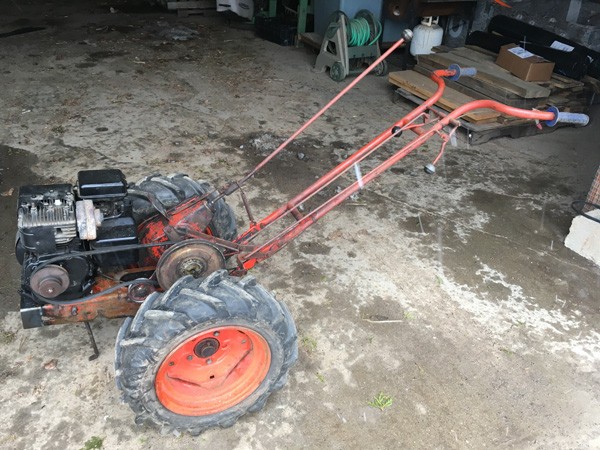
Each grower I spoke with had their own reason for gravitating towards walk-behinds and away from their 4-wheeled brethren. Jason Weston said, “I was raised being taught that tractors are your last resort, because of the soil compaction.” Will Staufer, “Yeah, I thought an Allis G would be nice, but after getting into these things I just don’t see the point.” Jeff Lauber told me, “When I was getting to farming, an Allis G cost ten times as much as a pick-up load full of walk-behind equipment, so it made way more sense to get it at this scale.”
In planning a project Peter, an Amish farmer I worked for, would say, “Ask around and learn as much as you can, and then you do as you please.” And so after prowling the internet and speaking to those with experience, it was time for Paul and me to build the cultivator of our dreams for his BCS tractor. He had bought a woefully inadequate cultivator, but it did come with a nice hitch that swiveled in two dimensions, fulfilling one of Boodog’s recommendations, and it was built with the proper hitch to attach to his BCS.
This toolbar was a good starting point from which to build. We were newbies, and so we wanted to make this tool as adjustable as possible so that Paul had options when it came to dialing it in. To that end I am a big fan of attaching the individual rows of cultivators to the frame with floating arms. Floating arms allow each individual blade to flex independently over the ground, additionally, they allow Paul to flip the blades up and out of the way when he needs to turn or travel with the cultivator. We made the arms floating by attaching them to the frame with one bolt, so that they can pivot on it, but also added a second hole so that with the second bolt in place the arm is pinned in a 90 degree position.
Below, floating arms with one bolt, allowing them to pivot. Note the second hole for a bolt that if added would lock the arm at 90 degrees. The back two arms are flipped up for travel. All images courtesy of the author unless otherwise noted.
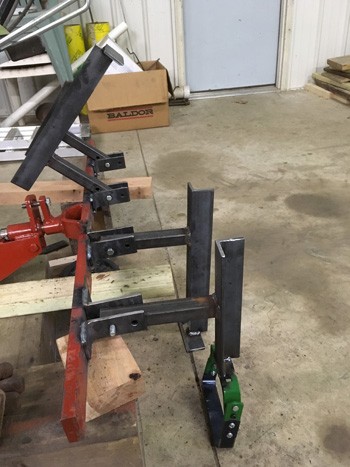
We did not have a ready source for coulters, so Paul had a local machine shop cut out 10’’ diameter wheels of 1/8’’ plate steel with a ½’’ hole in the middle for an axle pin. These wheels became our rear gauge-wheels and are mounted three feet back from the toolbar. I don’t feel that the exact dimensions of the structural steel used is crucial, we bought some and used some that was at the shop, always opting for bigger dimensions.
For the actual cultivating blades we chose two types so that Paul can decide which works best. The two outside blades are a scuffle-hoe type from Hoss Tools and the inner three “T” blades we made by grinding an edge on 3/8’’ bar stock. We wanted to try these “T” hoes because, by having the perpendicular shank mounted in the middle of the blade (looking like an upside down ‘T’), they allow the blade to get close to larger plants and underneath their foliage without the shank hitting the plant. In contrast, the perpendicular outer shanks of the Hoss scuffle hoe are mounted at the edges of the blade so that it cannot cultivate underneath foliage without those outer shanks hitting the plant. We will tell you after this season how these two types of blades performed.
Below, the toolbar hitch is attached to the tractor, red gauge-wheels await welding.
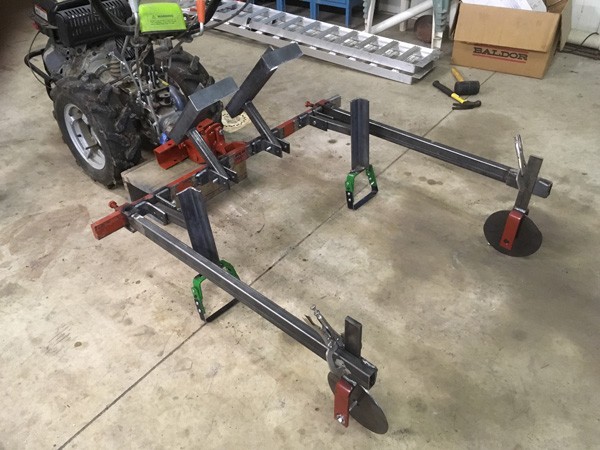
Better work always comes from better tools, so we turned to the team at Christel Solutions, a fabrication shop in Kiel Wisconsin, and they were kind enough to host us in their shop. While I thought I knew how to do simple things with metal like drill a hole, they showed us that there is a proper tool and technique for everything. Working in a well-appointed shop with experienced machinists really helped, and I would recommend you enlist anyone more experienced than you to assist with metalworking.
After talking with three walk-behind growers and plenty of Facebook pictures I realized that back in the day seventy years ago people were using tools that we now consider the hot new thing. Will showed me videos of the wire-weeder he had made, replicating the old design, and I saw that it worked wonderfully, stirring the soil to disrupt tiny weeds even while preserving young onions or carrots. Though our modern tools may do the work faster, they do not necessarily do the work better. And they may or may not be affordable or available. Walk-behind tractors are a bridge between the hand and tractor scale, offering a mechanized way of farming that still feels like it is on a human scale. They offer the benefits of an affordable scale where we can manage, repair and build our own tools. When I see these old tools working as well as we want our new tools to, I am reminded of Jeff Lauber’s words, “I don’t like when people say these tools are antiques. This is not antique equipment – it is as modern as the day it was built.”
Sam Hitchcock Tilton is a former and aspiring vegetable grower who has visited with farmers around the world. He is currently studying for a master’s degree at Michigan State University, focusing on organic weed control and researching, testing, and building mechanical weeding machines. He has a passion for developing the finest popcorn strain and enjoys learning more and sharing his knowledge.


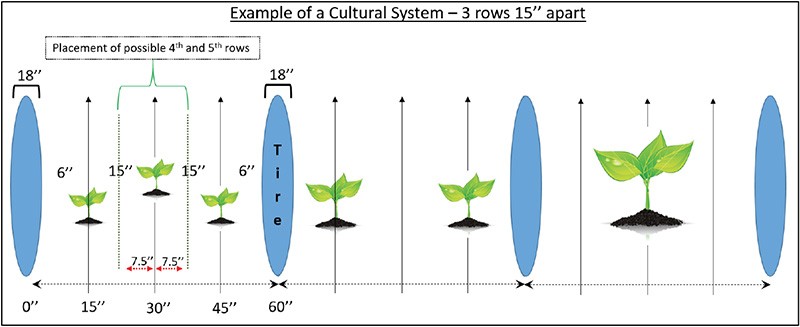 Like Indiana Jones tenaciously searching for the Holy Grail, similarly I, for years, have questioned farmers, searching for the one true row-spacing. With so many possible configurations for tractor-tire spacing, bed-top size, number of rows in a bed, and inches between rows – I felt there had to be one configuration to rule them all.
Like Indiana Jones tenaciously searching for the Holy Grail, similarly I, for years, have questioned farmers, searching for the one true row-spacing. With so many possible configurations for tractor-tire spacing, bed-top size, number of rows in a bed, and inches between rows – I felt there had to be one configuration to rule them all. 
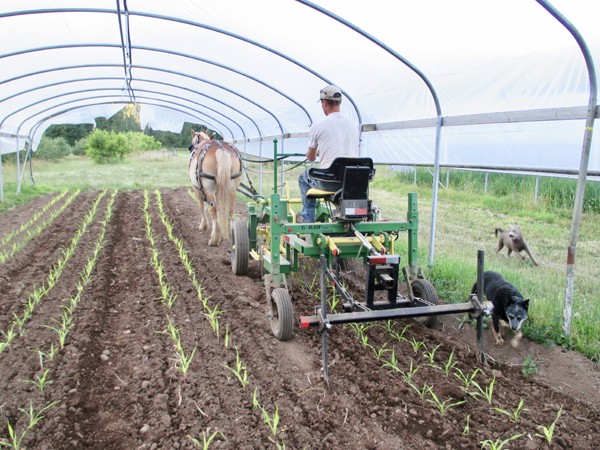 We have conducted several surveys of experienced teamsters to provide benchmark numbers for horse-powered market gardeners. These informal farm studies have covered everything from the economics of workhorse maintenance to the hours spent on fieldwork and harnessing. In this article, we report on a topic which may be of interest to growers who use tractors and hand tools: the effect of cropping systems on plant populations.
We have conducted several surveys of experienced teamsters to provide benchmark numbers for horse-powered market gardeners. These informal farm studies have covered everything from the economics of workhorse maintenance to the hours spent on fieldwork and harnessing. In this article, we report on a topic which may be of interest to growers who use tractors and hand tools: the effect of cropping systems on plant populations.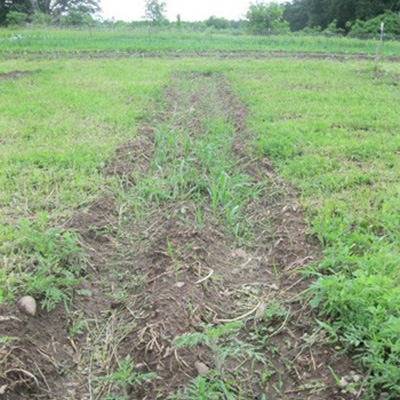
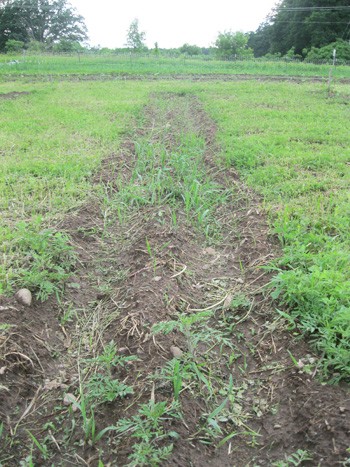 It’s no surprise that Quackgrass (Elymus repens) is also known as “The Devil’s Grass.” Thick mats of quackgrass can choke out crops and gardens alike. It encroaches from afar and grows back again and again after cutting and pulling. Rhizomes (underground stems) of this tough perennial grass can burrow as deep as eight inches in loose soil and grow over an inch per day, reaching lengths in excess of 10 feet. Broken bits of rhizomes can grow into entirely new plants, and disturbance often triggers dormant growth nodes to sprout new blades of grass. Quackgrass can dishearten even seasoned growers as a seemingly insurmountable problem.
It’s no surprise that Quackgrass (Elymus repens) is also known as “The Devil’s Grass.” Thick mats of quackgrass can choke out crops and gardens alike. It encroaches from afar and grows back again and again after cutting and pulling. Rhizomes (underground stems) of this tough perennial grass can burrow as deep as eight inches in loose soil and grow over an inch per day, reaching lengths in excess of 10 feet. Broken bits of rhizomes can grow into entirely new plants, and disturbance often triggers dormant growth nodes to sprout new blades of grass. Quackgrass can dishearten even seasoned growers as a seemingly insurmountable problem. 